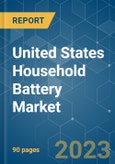The US household battery market is expected to register a CAGR of over 5% during the forecast period.
The market was negatively impacted by COVID-19. The market has now reached pre-pandemic levels.
This product will be delivered within 2 business days.
The market was negatively impacted by COVID-19. The market has now reached pre-pandemic levels.
Key Highlights
- With the increasing population and economic growth, the use of electronic appliances in the country is expected to grow over time. Household batteries are primarily used in electronic goods like smartphones, cameras, and many other electronic devices. The primary driver of the market studied is the growing use of electronic devices and technological development for longer-duration backup capabilities. Declining lithium-ion battery prices and technological developments are expected to drive the US household battery market during the forecast period.
- However, the demand-supply mismatch for raw material supply to manufacturing the batteries is expected to hinder the market growth during the forecast period.
- With an estimated population of around 398 million by 2050, the electronic market in the United States is expected to expand significantly. Technologies, such as developments in cell phone technology, and the implementation of artificial technology on electronic goods, are expected to transform digital technology to the way ahead. Moreover, the economy of the United States is expected to increase to USD 71,000 billion by 2050. Growth in the economy indicates growth in the lifestyle of people, thereby having a huge possibility for the adoption of updated technology, which is expected to create an opportunity for the market to grow in the near future.
US Household Battery Market Trends
Lithium-Ion Battery to Dominate the Market
- The lithium-ion battery is a type of rechargeable battery, majorly used in electronic devices and electric vehicles. It has been growing in popularity in various military and aeronautical uses. In 2021, lithium-ion batteries in the United States had a significant market share in the household battery market because of the increased use of electronic devices.
- Lithium-ion batteries are commonly used in electronic devices, such as smartphones, laptops, clocks, watches, and remote controls. Sales of consumer electronics are very much dependent on the population and disposable income. The increasing disposable income in the United States has led to rising living standards, driving the demand for consumer electronics in the country.
- Li-ion batteries have been gaining more popularity compared to other battery types due to their favorable capacity-to-weight ratio. Other factors boosting its adoption include better performance, higher energy density, and decreasing price.
- Mobile phones are the most commonly used electronic devices, which use lithium batteries. With about 298 million smartphone users by 2021, the United States has one of the world's largest smartphone markets. It is likely to increase further with technological development and a drop in the price of mobile phones.
- Due to the high competition in the consumer electronics market, the prices of technology have been reducing, while the disposable income of people has also been increasing, resulting in increased penetration levels of the devices. Similarly, the growth over the forecast period is expected to drive the demand for batteries used in these devices.
Declining Lithium-ion Battery Price and Technological Development to Drive the Market
- The price of lithium-ion batteries has fallen steeply over the past ten years. In 2018, the lithium-ion battery price was USD 176 per kWh. Lithium-ion battery prices have been falling continuously, decreasing to USD 132 kWh in 2021.
- This sharp and sustained cost reduction is expected to help cement lithium-ion as the battery chemistry of choice in all energy storage markets, including grid-scale, behind-the-meter storage, residential storage, and micro-grids.
- Lithium-ion batteries are expected to dominate the overall battery market over the next ten years, as they are widely used in cell phones, tablets, and laptops, among other gadgets, whose demand has been increasing at a significant rate globally and in the United States.
- Furthermore, the decline in average lithium-ion battery prices is expected to continue and reach approximately USD 100/kWh by 2025, making it much more cost-competitive than other battery types. The trend is likely to result in an increased application of lithium-ion batteries in many other consumer electronics, with a decrease in the price of household electronic goods during the forecast period.
US Household Battery Market Competitor Analysis
The household battery market in the United States is fragmented. The key owners in the market studied (not in particular order) include Duracell Inc., Energizer Holdings Inc., HBL Power Systems Ltd, BYD Company Ltd, Panasonic Corporation, Power-Sonic Corporation, and Zeus Battery Products, among others.Additional benefits of purchasing the report:
- The market estimate (ME) sheet in Excel format
- 3 months of analyst support
This product will be delivered within 2 business days.
Table of Contents
1 INTRODUCTION
4 MARKET OVERVIEW
5 MARKET SEGMENTATION - BY TYPE
6 COMPETITIVE LANDSCAPE
Companies Mentioned (Partial List)
A selection of companies mentioned in this report includes, but is not limited to:
- Duracell Inc.
- Energizer Holdings Inc.
- HBL Power Systems Ltd
- BYD Company Ltd
- Panasonic Corporation
- Power Sonic Corporation
- Zeus Battery Products
- Exide Technologies Inc.
Methodology

LOADING...










